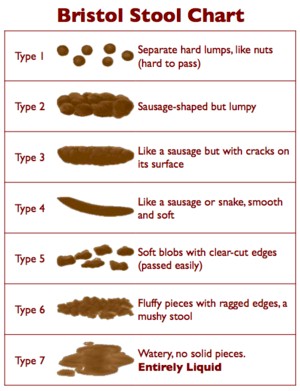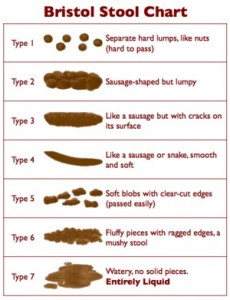Put down your coffee cup or whatever you may be eating. We’re about to get into the nitty gritty about dog poop. For 20+ years, I lived with dogs that had gastrointestinal (GI) diseases, so poop-patrol was a serious part of life. If you have one of these dogs, you know exactly what I’m talking about. You feel trepidation every time the dog defecates, stare at it, and pick through it with a stick if you can pick through it at all.
Many of my clients have dogs with GI diseases, and they try to be delicate when describing the stool, but after so many years of dealing with this, and especially with the addition of another 14+ years of working with clients, there’s probably nothing I haven’t seen or heard. Some clients become so frustrated by trying to find the right words that they resort to taking pictures and sending them to me so I can see for myself. My favorite was a picture of bright blue stool. Perfectly shaped mind you, but incredibly blue. Turned out the dog had counter surfed when a blueberry pie was sitting there and…well, you can guess the rest.
For those who are at a loss for words when trying to describe stool, this chart can be helpful.
Type 1 indicates constipation. That may not be a terrible thing now and then, but it shouldn’t be the norm.
Type 2, aka “Tootsie Roll Stool” and Type 3 are what most healthy dogs produce. Type 2 can be indicative of semi-constipation, but it’s usually helpful in expressing anal glands because it’s hard and very firm. Type 3 is considered to be a healthier stool, but both are fine. Type 3 should be seen more often than Type 2.
Type 4 may occur when the dog has eaten fruit or any other food (or food-like things if you’re a dog) in the yard, on a walk, etc. It can happen now and then, but usually firms up the next day. However, dogs with GI diseases who produce Type 4 will often produce Type 5, 6, or 7 quickly. Transit time is fast and stool becomes sloppier each time.
Type 5 can resolve quickly in healthy dogs.
Types 6 and 7…well, here’s some trouble. It may not be serious trouble, but the GI tract is trying to tell you something. Reduce food intake for the day, or fast the dog. Ensure water intake to keep the dog hydrated well. Unless there’s been some indiscriminate eating (sticks. bark, leaves, excess fruit/green veggies, the baby threw food on the floor and the dog ate it, your neighbor fed the dog a treat…pick one scenario), the cause can be just about anything. From a diet that’s too fatty to the dog having a parasite, pancreatic problem, or any other issue, Types 6 and 7 are a heads up that if this doesn’t resolve very quickly, a vet visit is in order.
For dogs that could use some improvement in healthy gut function, these products are what my clients find to be really helpful.
Acidophilus helps to strengthen the digestive tract by adding “good-guy” bacteria to the existing, healthy bacteria population in the dog’s gut.
Tannins (found in Antioxidant Booster) helps some cases of diarrhea. Digestive Enzymes or Plant Digestive Enzymes can benefit some dogs and may be a good adjunct to the correct diet. Remember that “correct” needs to be based on what a dog tolerates rather than on a certain belief system of what the dog “should” tolerate.
L-Glutamine is a supplement that can help to rebuild healthy tissues in the digestive tract and some dogs benefit from it immensely.


